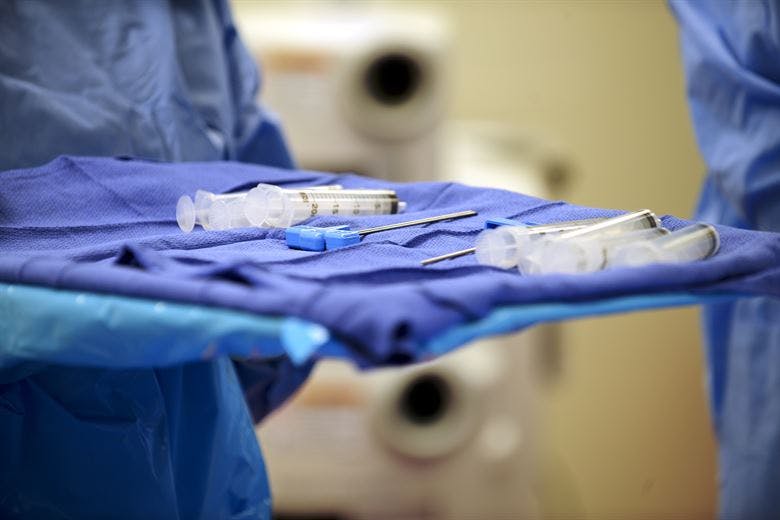Dr. Sophie Menkes, Professor Guy Magalon, Dr. Ali Modaressi and Dr. Jérémy Magalon co-host a training entitled "the power of an autologous procedure", in Geneva, on June 7th.
INVIVOX: Why choose cell therapy?
Dr Jérémy MAGALON: It is the only discipline in Medical Biology in which there is a therapeutic interest, and not diagnostic, for the patient. This is a relatively young science that relies on the use of "drug cells" and it is probably a way into the future.
INVIVOX: What are the main activities of a cell therapy department in a CHU?
Dr Jérémy MAGALON: We are in charge of cell therapy daily care for which we prepare cell grafts for the hematology and ophthalmology departments. We also prepare PRP (Platelet Rich Plasma) for APHM physicians, mostly for orthopedic applications. Beside caring, we do clinical research. We are conducting clinical trials using stem cells that are present in adipose tissue and which are very strictly regulated.
INVIVOX: What is Platelet Rich Plasma (PRP)?
It is an autologous therapy used in many medical and aesthetic indications that is prepared from the patient's blood. Platelets are a reservoir of growth factors and cytokines capable of stimulating the angiogenesis and regeneration of certain tissues.
INVIVOX: In which indications is the PRP used?
Dr Jérémy MAGALON: In France, PRP is reserved exclusively for therapeutic use. Since 2018, ANSM has clearly restricted the use of PRP only for therapeutic use in the same operating period, with a medical device exclusively dedicated to the preparation of PRP and benefiting from CE marking. It is not a question of using laboratory tubes only validated for the in vitro diagnosis! The platelet has no core in regards of European regulatory authorities, it is not considered as a cell. “de facto”, it does not have the same status as the stem cell. National regulation operates with differences between each country in Europe. PRP is widely used in orthopedics for osteoarthritis and tendinopathies. There are, however, "borderline" indications between therapeutics and aesthetics such as androgenetic alopecia. On this topic, meta-analyzes of controlled trials have shown that there is a favorable effect of PRP injections on the hair follicle.
INVIVOX: Are there any indications to discover with the PRP yet?
Dr Jérémy MAGALON: Yes, because PRP contains growth factors that influence healing and can therefore be used in many disciplines: dermatology, gynecology, urology, rheumatology, orthopedics, sports medicine.
INVIVOX: How many medical devices (PRP kits) are there on the market?
There are around twenty medical devices for preparing PRP in a single operation. The procedure involves taking a blood sample, centrifuging the blood using the medical device and then recovering the plasma and platelets (which are the lightest phases of the blood after centrifugation found on the surface of the device). must be reinjected. However, each kit requires taking different blood volumes depending on the manufacturer. There is a great variability in kits that can range from 8 to 150 ml of blood taken. The time, the speed and the number of centrifugation are therefore different from one kit to another. Consequence: the volume, the composition and the dose of platelets injected will be different. Even while still using the same device, there remains an inter-individual and an intra-individual variability. For a long time, the PRP has been considered as a product whose composition must be well known in order to inject it. It is for this reason that it is recommended to equip a cell counter and to characterize what will be injected. At the Forever Institute, practitioners have long followed these best practices, using a cell counter and reporting exactly what is injected to the patient.
To give an example: if I take the blood of the same patient and I use the 2 most extreme kits in terms of volume, I will get a dose that can vary by a factor of 25, which is a difference significant, and which will likely have consequences for the patient. It is therefore very important to be trained to understand these differences from one device to another and how to manage them safely for patients.
INVIVOX: What studies around PRP?
Dr Jérémy MAGALON: In 2018, we published in Arthroscopy a study using PRP in knee osteoarthritis, randomized double-blind, controlled against hyaluronic acid. A higher proportion of responders was observed in the PRP group (72.7% vs 45.8%), at the limit of significance (p = 0.064) because of the small size (n = 54) (Arthroscopy 2018, vol 34, Issue 5, pages 1530-1540). In 2019, we published an uncontrolled trial on a series of 60 patients of the rheumatology department of the Saint-Joseph Hospital in Marseille with larger volumes of PRP than in the previous study. We observed 80% of responders 6 months after treatment. These results are very encouraging. (Int. J. Mol. Sci. 2019, 20, 1327).
INVIVOX: Are there still any indications to discover with PRP?
Dr Jérémy MAGALON: Yes, because the PRP is relatively easy to access. The growth factors of PRP influence healing, tissue restoration so potentially, they can be used in any discipline.
INVIVOX: What are the advantages over synthetic products?
Dr Jérémy MAGALON: PRP is an autologous product without risk of immunogenicity unlike synthetic fillers. It's a technique that seems to me more secure. Hyaluronic acid seems to be easier and faster to use regarding the “ready for us” syringe. De facto, the PRP procedure is longer. However, it provides active ingredients like growth factors instead of an inert and potentially immunogenic product.
INVIVOX: Can we say that this technique has now come to maturity?
Dr Jérémy MAGALON: No, it is a technique still being evaluated with very encouraging meta-analysis results in osteoarthritis of the knee, for example. Unfortunately, too few scientific articles describe the PRP they inject limiting interpretations when it does not work! This is why recent US guidelines have emerged through the American Association of Orthopedic Surgeons (AAOS).
https://www.ncbi.nlm.nih.gov/pubmed/28012636
https://www.ncbi.nlm.nih.gov/pmc/articles/PMC6314629/pdf/jaaos-27-e50.pdf
INVIVOX: What is your "part" in this Forever Institute training?
Dr Jérémy MAGALON: After a history of the technique and an exhaustive description of the devices of the market, I wish to inform the participants of the international recommendations on this technique, as well as a part on the realization of the quality control of the PRP that they will have to administer to their patients.
INVIVOX: What is your target audience?
Dr Jérémy MAGALON: It is a training in good practices of the use of the PRP which is addressed to the dermatologists, aesthetic doctors, aesthetic surgeons mainly, as well as to the assistants implemented to realize the blood sample and preparation for quality control with the use of the meter. This training is open to beginners as well as to confirmed ones. The morning, devoted to the "preparation" component, can be very useful even for a practitioner who is used to PRP. The afternoon is dedicated to practice.
INVIVOX: What benefits will the participants get from this day?
Dr Jérémy MAGALON: We will show the participants the various ways of preparing the PRP, the different medical devices proposed by the manufacturers, and organize practical workshops with these devices where the PRP will be manufactured and controlled to the rules. This is essential because the patient must know what he has received and we know that the composition of the product influences its effectiveness and safety.

